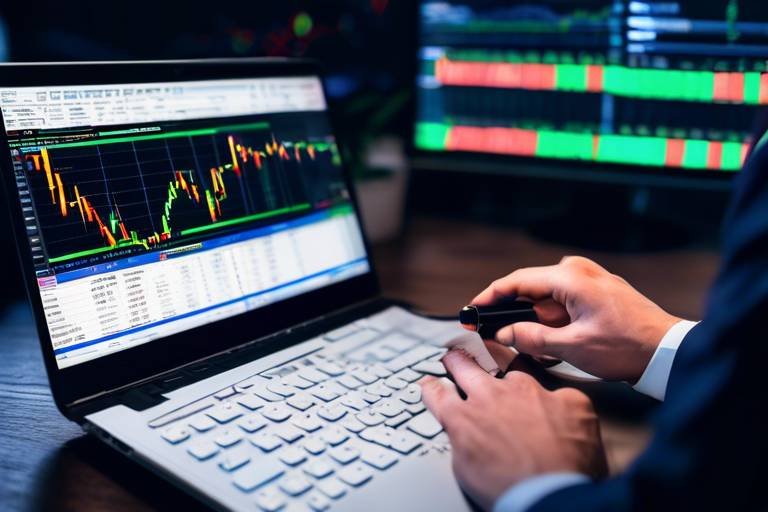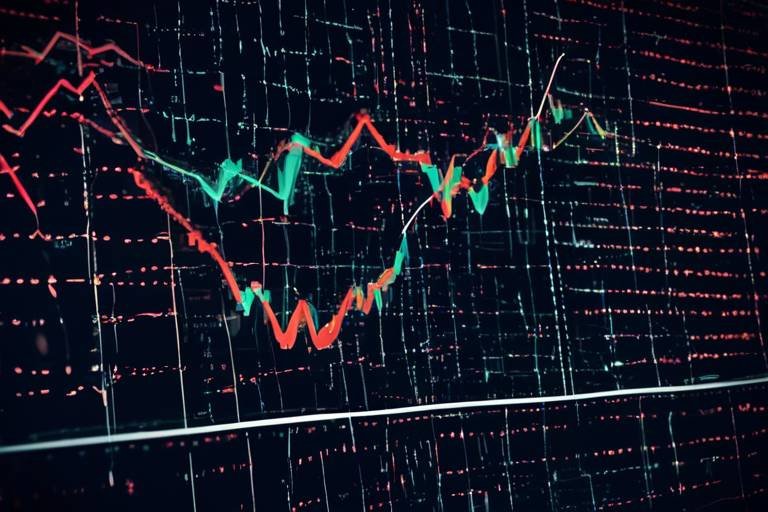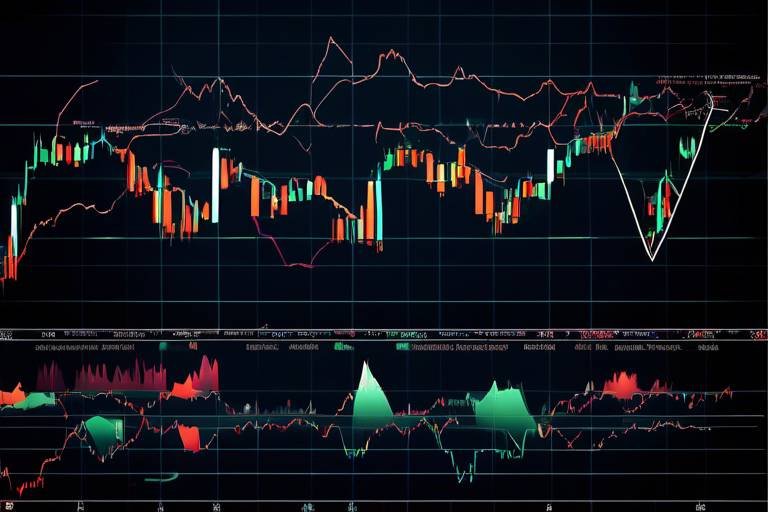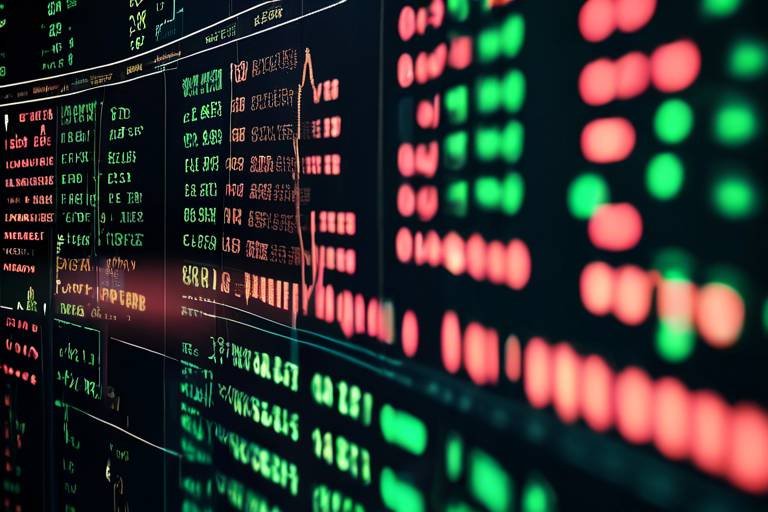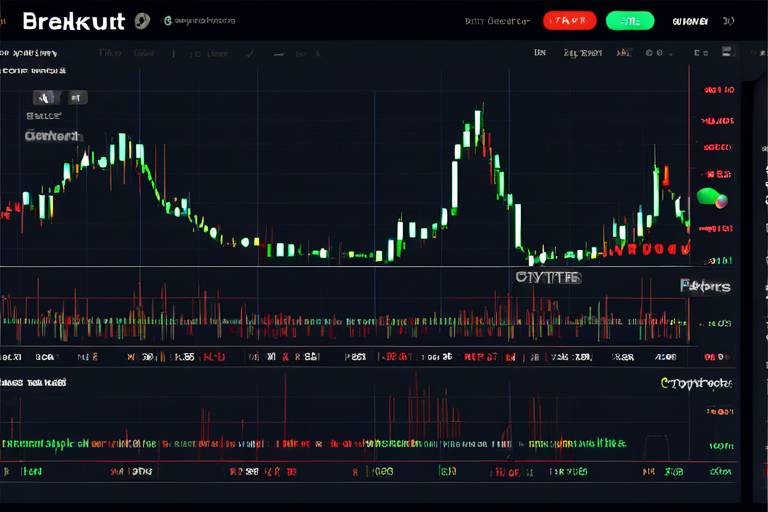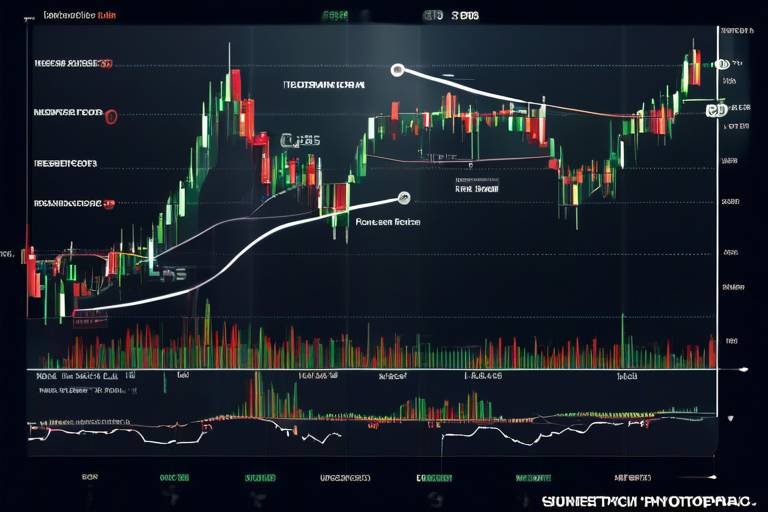The Importance of Chart Patterns in Cryptocurrency Analysis
In the ever-evolving world of cryptocurrency trading, understanding the nuances of market movements is crucial. One of the most effective ways to gain insights into these movements is through chart patterns. These visual indicators not only help traders identify potential trends and reversals but also empower them to make informed decisions. Imagine trying to navigate a stormy sea without a compass; chart patterns serve as that compass, guiding traders through the volatility of the cryptocurrency market.
Chart patterns are more than just pretty visuals; they encapsulate the psychology of market participants. When you look at a chart, you're witnessing the collective emotions of buyers and sellers. Are they feeling bullish or bearish? Are they ready to buy or sell? By interpreting these patterns, traders can anticipate future price movements, much like a weather forecaster predicting a storm. This ability to foresee market changes can significantly enhance trading strategies, allowing for timely entries and exits.
Moreover, the significance of chart patterns extends beyond mere prediction. They help in risk management as well. For instance, a trader who recognizes a reversal pattern can adjust their strategy to minimize losses or lock in profits before the market shifts. This proactive approach is vital in a market where prices can swing dramatically in a matter of hours. Therefore, mastering chart patterns is not just an option; it’s a necessity for anyone serious about trading cryptocurrencies.
As we dive deeper into the world of chart patterns, it’s essential to remember that they are not infallible. They should be used in conjunction with other analysis tools to create a robust trading strategy. By combining chart patterns with indicators like volume analysis and moving averages, traders can increase their chances of success. This holistic approach to trading transforms the way one interacts with the market, turning uncertainty into opportunity.
In conclusion, chart patterns are indispensable in the realm of cryptocurrency trading. They provide a visual representation of market sentiment, help in predicting price movements, and enable traders to manage their risks effectively. As the cryptocurrency market continues to grow and evolve, those who harness the power of chart patterns will undoubtedly find themselves at a significant advantage. So, the next time you look at a price chart, remember that you're not just seeing numbers; you're witnessing the pulse of the market.
- What are chart patterns? Chart patterns are graphical representations of price movements that help traders identify potential market trends and reversals.
- Why are chart patterns important in cryptocurrency trading? They provide insights into market sentiment, help predict future price movements, and assist in risk management.
- Can chart patterns guarantee profits? While they can enhance trading strategies, chart patterns are not foolproof and should be used alongside other analysis tools.
- How can I learn to recognize chart patterns? Familiarizing yourself with different patterns through practice and studying market charts can help you become proficient in recognizing them.

Understanding Chart Patterns
Chart patterns are the **visual language** of the cryptocurrency market, speaking volumes about trader sentiment and potential price movements. Imagine walking through a bustling marketplace where every stall represents a different cryptocurrency. Just like you would observe the crowd's behavior to gauge the popularity of certain products, chart patterns allow traders to interpret price action and predict future trends. By studying these graphical representations, traders can gain insights into whether the market is likely to continue in its current direction or if a reversal is on the horizon.
At their core, chart patterns are formed by the price movements of a cryptocurrency over time. These patterns can emerge over various time frames, from minutes to days, and even weeks. Understanding these patterns is not just about memorizing shapes; it’s about reading the **emotions** behind the market's movements. When prices rise, it often reflects **optimism** and **demand**, while falling prices can indicate **fear** and **selling pressure**. Thus, recognizing these emotional undercurrents through chart patterns is crucial for any trader aiming to navigate the unpredictable waters of cryptocurrency trading.
Moreover, chart patterns can be broadly categorized into two types: **continuation patterns** and **reversal patterns**. Continuation patterns suggest that the existing trend will persist, while reversal patterns indicate a shift in the market's direction. Familiarizing oneself with these categories can significantly enhance a trader's ability to make informed decisions. For instance, if a trader identifies a continuation pattern, they might choose to ride the wave of momentum, whereas spotting a reversal pattern could prompt them to exit a position or consider a counter-trend strategy.
To delve deeper into understanding chart patterns, one must also consider the **context** in which they appear. A pattern that forms after a significant price movement can carry different implications than one that appears during a period of consolidation. This context is where the real art of trading comes into play, as traders must blend technical analysis with their own market intuition. By honing this skill, traders can better anticipate market behavior and position themselves for success.
In summary, mastering chart patterns is akin to learning a new language; it requires practice, patience, and a keen eye for detail. As traders become more fluent in this visual dialect, they can leverage these insights to make **strategic decisions** that align with their trading goals. The journey of understanding chart patterns is not just about improving trading skills; it's about becoming a more **confident** and **informed** participant in the ever-evolving world of cryptocurrency.

Types of Chart Patterns
When diving into the world of cryptocurrency trading, understanding the is essential. These patterns are like roadmaps that guide traders through the often turbulent waters of the market. By recognizing these patterns, traders can gain insights into potential price movements and make more informed decisions. Chart patterns are generally categorized into two main types: continuation patterns and reversal patterns. Each type serves a different purpose, and knowing the distinction can significantly enhance your trading strategy.
Continuation patterns suggest that the current trend will persist after a brief pause, while reversal patterns indicate a potential change in the existing trend direction. Let's break these down further to understand their implications better.
Continuation patterns are indicators that the market is likely to continue its current trend after a short consolidation phase. Think of these patterns as a runner taking a quick breather before sprinting toward the finish line. They are crucial for traders looking to ride the momentum of existing trends. Some common continuation patterns include:
- Flags: These appear as small rectangles that slope against the prevailing trend. They often follow a strong price movement and indicate a brief pause before the trend resumes.
- Pennants: Similar to flags, pennants form after a significant price movement but take the shape of a small symmetrical triangle. They indicate that the market is consolidating before continuing in the same direction.
- Triangles: Triangles can be ascending, descending, or symmetrical. They represent periods of consolidation where the price moves within converging trendlines. Traders often look for breakout points from these patterns.
Recognizing these continuation patterns can provide traders with valuable entry points, allowing them to capitalize on ongoing market momentum. The key is to watch for confirmation signals, such as volume spikes, which can validate the likelihood of the trend continuing.
On the flip side, reversal patterns signal that the current trend may be coming to an end. They act like warning signs, alerting traders to potential shifts in market direction. Understanding these patterns can be a game-changer, as they help traders avoid losses and position themselves for new opportunities. Common reversal patterns include:
- Head and Shoulders: This pattern resembles a head with two shoulders on either side. It typically indicates a bullish trend is about to reverse into a bearish trend.
- Double Tops and Bottoms: A double top occurs when the price reaches a peak twice before reversing downward, while a double bottom indicates a price that hits a low twice before reversing upward.
- Inverse Head and Shoulders: This is the opposite of the head and shoulders pattern and signals a potential bullish reversal.
By identifying these reversal patterns, traders can make timely decisions to exit positions or enter new ones, ultimately maximizing their profit potential. The importance of mastering both continuation and reversal patterns cannot be overstated, as they are fundamental tools in a trader's arsenal.
In conclusion, understanding the is vital for anyone looking to navigate the cryptocurrency market successfully. By familiarizing yourself with these patterns, you can enhance your trading strategies and make more informed decisions. Remember, the key to success in trading often lies in the details, and chart patterns provide those crucial insights that can set you apart from the crowd.

Continuation Patterns
Continuation patterns are like the calm before the storm in the world of cryptocurrency trading. They signal that a trend, whether bullish or bearish, is likely to persist after a brief period of consolidation. Imagine you're driving down a highway, and you see a sign indicating a rest area ahead. This is akin to a continuation pattern; it's a pause in your journey, but it doesn’t mean you’re changing direction. Instead, you’re gearing up to resume your original path, and that’s precisely what these patterns indicate for traders.
Recognizing continuation patterns can be a game-changer for traders looking to capitalize on existing market momentum. Some of the most common types of continuation patterns include flags, pennants, and triangles. Each of these patterns comes with its unique characteristics, but they all share the common theme of indicating that the prevailing trend is likely to continue.
Let’s dive a bit deeper into these patterns:
- Flags: Flags appear as small rectangular shapes that slope against the prevailing trend. They form after a strong price movement, followed by a period of consolidation. Think of them as a brief pause for breath before the price continues in the same direction.
- Pennants: Similar to flags, pennants also indicate a pause in the trend but are characterized by converging trend lines. They look like a small symmetrical triangle and often follow a significant price move. The breakout from a pennant can lead to a powerful continuation of the trend.
- Triangles: Triangles can be ascending, descending, or symmetrical. Each type has its unique implications regarding the direction of the breakout. For example, an ascending triangle often indicates bullish sentiment, while a descending triangle may suggest bearish momentum.
Understanding these patterns is crucial for traders because they provide potential entry points that can lead to substantial profits. By identifying a continuation pattern, traders can set their buy or sell orders just above or below the pattern’s breakout point, ensuring they are in the right place at the right time.
Moreover, the effectiveness of these patterns is significantly enhanced when combined with volume analysis. A breakout accompanied by high trading volume is often a stronger signal than one with low volume. This is because high volume suggests that there is strong market interest and conviction behind the price movement, making it more likely that the trend will continue.
In conclusion, mastering continuation patterns can give traders a significant edge in the fast-paced cryptocurrency market. By recognizing these patterns and understanding their implications, traders can make informed decisions that align with the prevailing market trends, ultimately enhancing their trading strategies and maximizing potential profits.

Flags and Pennants
Flags and pennants are fascinating chart patterns that traders often encounter in the cryptocurrency market. These patterns are essentially short-term continuation signals, indicating that a prevailing trend is likely to resume after a brief consolidation phase. Imagine you're watching a thrilling race; just when you think the runners are slowing down for a break, they suddenly sprint ahead again. That's the essence of flags and pennants in trading!
Flags typically appear as rectangular shapes that slope against the prevailing trend, resembling a flag on a pole. They form after a strong price movement, followed by a period of consolidation where the price moves sideways or slightly retraces. On the other hand, pennants look like small symmetrical triangles that form after a strong price move, indicating a brief pause before the trend resumes. To visualize this, think of a coiled spring that’s about to release energy; it builds up tension before launching into action!
Identifying these patterns can significantly enhance a trader's ability to make informed decisions. For instance, when a trader spots a flag pattern, they might consider entering a position as the price breaks out in the direction of the previous trend. This is crucial because the breakout often leads to a continuation of the prior momentum, providing an excellent opportunity for profit.
| Pattern Type | Formation | Trading Strategy |
|---|---|---|
| Flag | Rectangular shape, sloping against the trend | Buy on breakout above the flag |
| Pennant | Symmetrical triangle after a strong price move | Buy on breakout above the upper trendline |
Moreover, traders can enhance their strategies by paying attention to volume during these formations. Ideally, the volume should decrease during the flag or pennant formation and then increase significantly upon breakout. This increase in volume acts as a confirmation of the breakout's validity, reinforcing the trader's decision to enter the market.
In summary, flags and pennants are essential tools in a trader's arsenal. Understanding how to recognize and trade these patterns can provide a significant edge in the fast-paced world of cryptocurrency trading. As with any trading strategy, practice and experience are key. So, keep your eyes peeled for these patterns, and you might just find that they lead you to profitable opportunities!
- What is the difference between flags and pennants?
Flags are rectangular shapes that slope against the prevailing trend, while pennants are small symmetrical triangles that form after a strong price movement. - How can I confirm a breakout from a flag or pennant?
Look for an increase in volume as the price breaks above the pattern's resistance level; this signals a stronger likelihood of a continuation. - Are flags and pennants reliable patterns?
While they can be very effective, it's essential to combine them with other indicators for a more comprehensive trading strategy.

Triangles
Triangles are fascinating chart patterns that traders often encounter in the bustling world of cryptocurrency. These patterns emerge during periods of consolidation, where the price action narrows down, creating a visual representation of indecision in the market. What makes triangles particularly intriguing is their ability to signal potential breakout points, which can lead to significant price movements. There are three primary types of triangle patterns: ascending, descending, and symmetrical. Each of these offers unique insights into market sentiment and potential future trends.
When you look at an ascending triangle, you’ll notice that the upper trend line is flat while the lower trend line slopes upwards. This indicates that buyers are becoming increasingly aggressive, pushing the price higher while sellers are holding their ground. The breakout from this pattern typically occurs to the upside, making it a bullish signal. On the other hand, a descending triangle features a flat lower trend line and a downward-sloping upper trend line. This suggests that sellers are gaining control, and a breakout from this pattern is generally bearish, indicating a potential decline in price.
The symmetrical triangle is a bit different; it has both upper and lower trend lines converging towards a point. This pattern represents a tug-of-war between buyers and sellers, with neither side gaining a clear advantage. The breakout direction can be either upward or downward, making it crucial for traders to monitor volume and market conditions closely to determine the likely outcome. Understanding these triangles is essential for traders looking to capitalize on potential price movements.
To further illustrate the significance of triangle patterns, here's a simple table outlining the characteristics of each type:
| Type of Triangle | Trend Lines | Market Sentiment | Typical Breakout Direction |
|---|---|---|---|
| Ascending Triangle | Flat upper, upward-sloping lower | Bullish | Upward |
| Descending Triangle | Flat lower, downward-sloping upper | Bearish | Downward |
| Symmetrical Triangle | Converging upper and lower | Indecisive | Can break either way |
In summary, triangle patterns are not just pretty shapes on a chart; they are powerful tools that can help traders navigate the unpredictable waters of cryptocurrency trading. By recognizing these patterns and understanding their implications, traders can make more informed decisions, potentially leading to profitable trades. So, the next time you spot a triangle on your chart, remember that it could be the key to unlocking your next trading opportunity!
- What is the significance of triangle patterns in trading?
Triangle patterns help traders identify potential breakout points, indicating future price movements. - How can I confirm a triangle pattern?
Look for converging trend lines and monitor volume during the breakout for confirmation. - Are triangle patterns reliable?
While they can provide valuable insights, it's essential to combine them with other indicators for better accuracy.

Reversal Patterns
Reversal patterns are like the sudden plot twists in your favorite movie—just when you think you know how it’s going to end, everything changes! In the fast-paced world of cryptocurrency trading, recognizing these patterns can be the difference between a profitable trade and a costly mistake. These patterns signal a potential change in the prevailing trend direction, alerting traders to the possibility that the market might be about to shift gears. Understanding reversal patterns is essential for traders who want to stay ahead of the curve and avoid being caught off guard by sudden market movements.
There are several key types of reversal patterns that traders should familiarize themselves with. Each of these patterns tells a unique story about market sentiment and can provide valuable insights into future price movements. Some of the most common reversal patterns include:
- Head and Shoulders: This classic pattern indicates a bullish-to-bearish reversal. It consists of three peaks—two smaller ones (the shoulders) surrounding a larger peak (the head). When the price breaks below the neckline formed by connecting the lows, it often signals a strong trend reversal.
- Inverse Head and Shoulders: The opposite of the head and shoulders pattern, this indicates a bearish-to-bullish reversal. It features a larger trough (the head) flanked by two smaller troughs (the shoulders) and is a strong indicator of a potential upward trend.
- Double Top and Double Bottom: The double top pattern occurs when the price hits a high twice before reversing downward, signaling a potential trend reversal. Conversely, the double bottom pattern sees the price hit a low twice before reversing upward, indicating a shift from bearish to bullish sentiment.
Recognizing these patterns can help traders make informed decisions about when to enter or exit positions. However, it’s important to remember that no pattern is foolproof. Always consider the broader market context and use additional indicators to confirm your analysis. For instance, combining reversal patterns with volume analysis can provide deeper insights into the strength of a potential reversal. If a reversal pattern is accompanied by a significant increase in trading volume, it adds credibility to the signal, suggesting that the market is genuinely shifting.
In conclusion, mastering reversal patterns is crucial for any trader looking to navigate the unpredictable waters of cryptocurrency. By keeping an eye out for these telltale signs, traders can position themselves to capitalize on new trends and avoid costly missteps. Just like a skilled detective piecing together clues, understanding reversal patterns allows you to decode the market's intentions and act accordingly.
Q: What are reversal patterns in cryptocurrency trading?
A: Reversal patterns are formations on a price chart that indicate a potential change in the direction of the market trend. They signal that the current trend may be coming to an end and a new trend may be beginning.
Q: How can I identify reversal patterns?
A: Traders can identify reversal patterns by looking for specific formations such as head and shoulders, inverse head and shoulders, double tops, and double bottoms on price charts. Combining these patterns with volume analysis can enhance their reliability.
Q: Are reversal patterns always reliable?
A: While reversal patterns can provide valuable insights, they are not foolproof. It's essential to consider the broader market context and use additional indicators to confirm potential trend reversals.
Q: Can I use reversal patterns in other markets besides cryptocurrency?
A: Absolutely! Reversal patterns are not limited to cryptocurrency; they can be applied in various financial markets, including stocks, forex, and commodities.

Importance of Volume in Chart Patterns
When diving into the world of cryptocurrency trading, one cannot underestimate the importance of volume as a crucial element in chart pattern analysis. Volume represents the number of assets traded over a specific period, acting as a barometer for market activity. Think of it like the heartbeat of the market; without understanding it, you might miss vital signs of potential price movements.
Volume provides insights into the strength or weakness of a price trend. For instance, if a cryptocurrency is experiencing a price increase accompanied by high volume, it often indicates that the trend is strong and likely to continue. Conversely, if prices rise but volume is low, it may suggest a lack of conviction among traders, hinting that a reversal could be on the horizon. This is why monitoring volume alongside chart patterns is essential for making informed trading decisions.
To better illustrate the relationship between price movements and volume, consider the following table that outlines different scenarios:
| Price Movement | Volume Behavior | Market Implication |
|---|---|---|
| Price Increase | High Volume | Strong Uptrend Likely |
| Price Increase | Low Volume | Weak Trend, Possible Reversal |
| Price Decrease | High Volume | Strong Downtrend Likely |
| Price Decrease | Low Volume | Weak Trend, Possible Reversal |
Additionally, volume can help confirm chart patterns. For example, if a trader identifies a breakout from a resistance level, a corresponding surge in volume can validate the breakout, indicating that the price movement is genuine rather than a false signal. On the flip side, if the breakout occurs with low volume, it might be wise to approach the situation with caution, as it could lead to a false breakout.
In practice, integrating volume analysis with chart patterns allows traders to enhance their decision-making process. By observing how volume behaves in relation to price movements, traders can develop a more nuanced understanding of market dynamics. For instance, if a trader sees a flag pattern forming on a chart, they should also look for volume spikes to confirm the continuation of the trend. This holistic approach can significantly improve the chances of successful trades.
In conclusion, volume is not just a number; it is an essential component of chart pattern analysis that can provide invaluable insights into market behavior. By paying close attention to volume alongside price movements, traders can make more informed decisions, ultimately increasing their potential for success in the ever-evolving cryptocurrency landscape.
- What is volume in cryptocurrency trading? Volume refers to the total number of coins or tokens that have been traded during a specific timeframe.
- Why is volume important in chart patterns? Volume helps confirm the strength of price movements and can indicate whether a trend is likely to continue or reverse.
- How can I analyze volume effectively? Traders often look for volume spikes during breakouts or reversals and compare volume levels to historical data for context.
- Can low volume be a warning sign? Yes, low volume during a price increase may indicate a weak trend and potential reversal, so it’s essential to be cautious.

Volume Analysis Techniques
When it comes to trading cryptocurrencies, understanding is like having a secret weapon in your arsenal. Volume, which refers to the number of assets traded during a specific period, can reveal a lot about market sentiment and potential price movements. For instance, a price increase accompanied by high volume often indicates strong buying interest, while a price increase on low volume may suggest a lack of conviction among traders. This is where the magic of volume analysis comes into play!
One of the most effective techniques is the Volume Moving Average. By calculating the average volume over a set period, traders can identify whether the current volume is above or below the average. If the volume is significantly higher than the average, it may signal a strong trend, while lower volume could indicate a potential reversal or consolidation. This technique is particularly useful during breakout scenarios, where high volume can confirm that the trend is likely to continue.
Another technique worth mentioning is the On-Balance Volume (OBV). This indicator combines price movement with volume to provide a clearer picture of market trends. The idea behind OBV is simple: when the price closes higher than the previous close, the volume for that day is added to the OBV total. Conversely, if the price closes lower, the volume is subtracted. Traders often look for divergences between the OBV and price trends to spot potential reversals. For example, if the price is rising but the OBV is falling, it might indicate a weakening trend.
Additionally, traders should consider the Accumulation/Distribution (A/D) line. This indicator measures the cumulative flow of money into and out of an asset. A rising A/D line suggests that accumulation is occurring, which can be a bullish sign, while a declining A/D line indicates distribution, signaling potential bearish trends. By monitoring the A/D line alongside price movements, traders can gain insights into the underlying strength of a trend.
Incorporating volume analysis into your trading strategy can help you make more informed decisions. Here’s a quick summary of the key techniques:
| Technique | Description |
|---|---|
| Volume Moving Average | Calculates average volume over a period to assess market strength. |
| On-Balance Volume (OBV) | Combines price movement with volume to identify trends. |
| Accumulation/Distribution (A/D) Line | Measures money flow to indicate bullish or bearish trends. |
Ultimately, mastering volume analysis techniques can enhance your trading strategy and help you navigate the often unpredictable waters of the cryptocurrency market. Remember, volume is not just a number; it tells a story about the market's emotional pulse. So, the next time you analyze a chart, pay close attention to the volume behind the price action—it might just lead you to your next big trading opportunity!
- What is the significance of volume in trading? Volume helps traders understand market strength and can confirm price movements.
- How can I effectively use volume in my trading strategy? Incorporate volume analysis techniques like OBV and A/D to gauge market sentiment.
- Can volume analysis predict price movements? While it can provide insights, no method is foolproof. It's best used in conjunction with other indicators.

Combining Chart Patterns with Other Indicators
When it comes to trading in the cryptocurrency market, relying solely on chart patterns can be like trying to navigate a maze without a map. Sure, chart patterns provide valuable insights into market trends, but integrating them with other technical indicators can significantly enhance your trading strategy. Think of it as adding a turbo boost to your trading engine. By combining chart patterns with indicators such as moving averages, Relative Strength Index (RSI), and Bollinger Bands, you create a multi-dimensional view of the market that can lead to better decision-making.
For instance, moving averages can help smooth out price data, making it easier to identify the overall trend. When a trader observes a bullish chart pattern, like a cup and handle, and notices that the price is above the moving average, it can serve as confirmation that the trend is likely to continue. This synergy not only boosts confidence in your trades but also minimizes the risk of false signals.
Moreover, the RSI is another powerful tool that can be used alongside chart patterns. It measures the speed and change of price movements and can indicate overbought or oversold conditions. When combined with a reversal pattern, such as a head and shoulders, the RSI can provide critical confirmation. For example, if the RSI shows that the asset is overbought while forming a head and shoulders pattern, it may suggest that a price reversal is imminent. This kind of analysis allows traders to make more informed decisions and increases the likelihood of successful trades.
Additionally, incorporating volume as an indicator can offer further validation. Volume can confirm the strength of a breakout from a chart pattern. If a trader spots a bullish flag pattern and observes a surge in volume during the breakout, it indicates strong buying interest and increases the probability that the price will continue to rise. Conversely, a breakout on low volume might signal a lack of conviction, prompting traders to exercise caution.
To illustrate how these combinations can work in practice, consider the following table:
| Chart Pattern | Indicator | Confirmation Signal |
|---|---|---|
| Cup and Handle | Moving Average | Price above the moving average |
| Head and Shoulders | RSI | RSI indicates overbought conditions |
| Bullish Flag | Volume | Increase in volume during breakout |
In summary, combining chart patterns with other indicators creates a robust framework for trading. It allows traders to validate their strategies, minimize risks, and enhance their chances of success in the unpredictable world of cryptocurrency trading. The more tools you have in your trading toolbox, the better prepared you will be to navigate the market's twists and turns.
- What are chart patterns? Chart patterns are graphical representations of price movements that help traders identify potential market trends and reversals.
- Why should I combine chart patterns with other indicators? Combining chart patterns with other indicators enhances the accuracy of your analysis and helps confirm trading signals.
- What are some common indicators to use with chart patterns? Common indicators include moving averages, RSI, and volume analysis.
- How can I identify a reliable breakout? A reliable breakout is often confirmed by increased volume and alignment with other indicators.

Practical Applications of Chart Patterns
Understanding and applying chart patterns can be a game-changer for traders navigating the often turbulent waters of the cryptocurrency market. These patterns not only provide visual cues about potential price movements but also empower traders to make informed decisions that can significantly impact their profitability. Imagine standing at a crossroads, with chart patterns acting as signposts guiding you toward the best trading opportunities. By recognizing these patterns, traders can better anticipate market behavior and position themselves strategically.
One of the most practical applications of chart patterns is in identifying entry and exit points. For instance, when a trader spots a bullish flag pattern, it signals that the price may break out to the upside after a brief consolidation. This knowledge allows traders to enter a position just before the anticipated upward movement, maximizing their potential profits. Conversely, recognizing a bearish reversal pattern, such as the head and shoulders, can prompt traders to exit their positions before a downward trend takes hold, thereby minimizing losses.
Moreover, chart patterns can serve as a foundation for developing a trading strategy. Traders often combine multiple patterns with other technical indicators to create a robust approach. For example, a trader might look for a triangle pattern and confirm it with a moving average crossover. This multi-faceted strategy increases the probability of making successful trades, as it relies on various signals rather than a single indicator. By doing so, traders can enhance their market analysis and boost their confidence in their trading decisions.
To illustrate this further, consider the following table that highlights some common chart patterns and their practical applications:
| Chart Pattern | Type | Practical Application |
|---|---|---|
| Flags | Continuation | Enter a trade after the breakout for potential upward movement. |
| Head and Shoulders | Reversal | Exit a long position to avoid losses before a downward trend. |
| Triangles | Continuation/Reversal | Monitor for breakout points to capitalize on price movements. |
In addition to entry and exit strategies, chart patterns can also assist in risk management. By understanding where to place stop-loss orders based on the identified patterns, traders can protect their capital from unexpected market swings. For instance, if a trader enters a position based on a bullish pattern, they might set their stop-loss just below the last support level indicated by the pattern. This way, they limit potential losses while allowing room for the trade to develop.
Finally, continuous practice and observation are essential for mastering the practical applications of chart patterns. Engaging in simulated trading or back-testing strategies can provide valuable insights into how these patterns behave in different market conditions. The more familiar traders become with recognizing and interpreting these patterns, the more confident they will be in their trading decisions.
- What are chart patterns?
Chart patterns are graphical representations of price movements that help traders identify potential market trends and reversals. - How can I use chart patterns in my trading?
Traders can use chart patterns to identify entry and exit points, develop trading strategies, and manage risk effectively. - Are chart patterns reliable indicators?
While chart patterns can provide valuable insights, they should be used in conjunction with other technical indicators for better accuracy. - How do I practice identifying chart patterns?
Engaging in simulated trading or back-testing strategies can help traders become more proficient at recognizing chart patterns.
Frequently Asked Questions
- What are chart patterns in cryptocurrency trading?
Chart patterns are visual representations of price movements over time. They help traders identify potential market trends and reversals, acting as indicators for making informed trading decisions.
- How do I recognize continuation patterns?
Continuation patterns, like flags and pennants, appear after a price trend and indicate that the trend is likely to continue. Look for brief consolidations followed by a breakout in the same direction as the prior trend.
- What are reversal patterns, and why are they important?
Reversal patterns signal a change in the prevailing trend direction. Recognizing these patterns is crucial as they can help traders avoid losses and seize new market opportunities when trends shift.
- Why is volume important in chart pattern analysis?
Volume provides insight into the strength of a price movement. Analyzing volume alongside chart patterns helps confirm their validity, allowing traders to make more informed decisions about potential breakouts or reversals.
- Can I combine chart patterns with other indicators?
Absolutely! Combining chart patterns with indicators like moving averages or the Relative Strength Index (RSI) can enhance your trading strategy, providing a more comprehensive view of market conditions and improving your chances of success.
- How can I apply chart patterns in real trading scenarios?
To apply chart patterns effectively, practice identifying them in historical price charts, and then look for similar setups in real-time markets. This hands-on approach can significantly improve your ability to make timely and profitable trading decisions.




